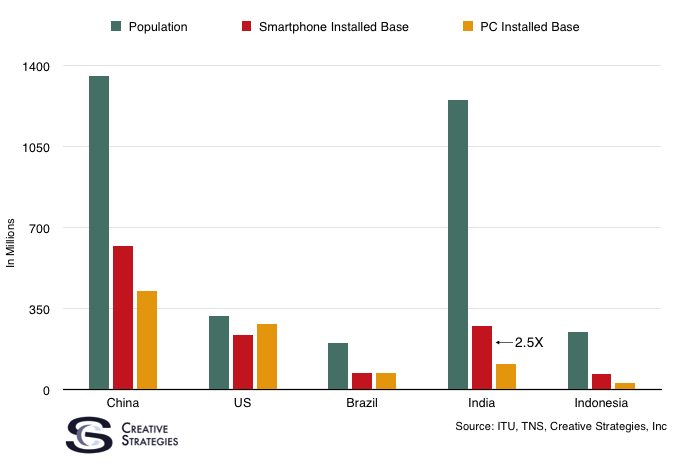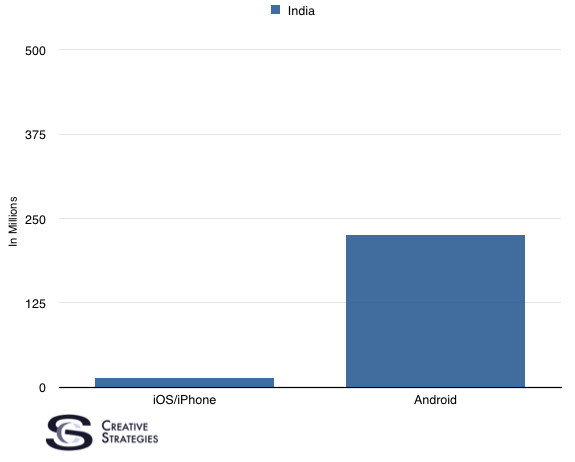Every market I study is fascinating in its own right. What keeps surprising me is the seeing how different things are in the markets I study. It would easier if all the markets were roughly the same, with the same brands, products, business models, et., all paralleling each other. But this would also be boring. I’ve outlined what is happening in China with mobile devices and the mobile internet on several occasions. Now I want to dive into India.
Mobile Only
I model global installed base of devices and platforms by country. There are several insightful points to understand about the India smart device landscape. The first is PC penetration is exceptionally low for such a large country. PC penetration (stat includes household, individual ownership, business, and Internet Cafe) in China is over 400m. In terms of pure volume, China and the US have the most mature PC audience respectively. In India, PC penetration is 10%. That breaks out to just over 100m PCs in a country of over 1 billion people. The PC in India is largely a work/business/productivity device and reflective of the number of tech workers or healthy individuals in the region. Yet, the number of smartphones in active use in India is over 250 million. Which makes India the country with the largest number of mobile/smartphone only internet users.

India is shaping up to be the feature market showing us what a mobile-only world looks like.
One of the key stats we uncovered that got me looking into India as a template to understand mobile only markets was the share of mobile commerce, as a percent, of e-commerce vs other countries. India has the highest share of m-commerce transactions as a percent of total e-commerce than any country. Mobile share of total e-commerce transactions in India is 43%. The next closest is China where m-commerce makes up 32% of e-commerce transactions. Every other country is distant at 20% or below share of mobile commerce.
This incredible emphasis on mobility, where the mobile internet is truly the only consumer internet in India has led companies like Flipkart (the leading e-commerce company in India) to shut down their desktop website and only offer their service through a mobile app. Myntra, a Flipkart property, is also going in mobile and shutting down their desktop website. While these are several examples of companies who had a PC focus and shifted to mobile only, dozens of upstarts in India are starting with mobile only businesses and never bothering to develop a desktop website.
This is again because the internet in India is primarily mobile and with regard to the consumer-centric mobile internet it is absolutely mobile only. Because of this, we will see mobile only innovation coming out of India which we can use as case studies for other markets. I’m watching for new services in banking and finance, payments and micropayments, e-commerce/m-commerce, hyper-local services like fresh food delivery, and more. These areas are all growing out of a mobile-first environment where, even though I’m watching these services in other countries, many in Western markets particularly will still embrace the desktop web. My thesis is, the ones who focus mobile only will bring out innovations not seen yet by those who still embrace both mobile and desktop experiences. In all the areas above, from mobile banking, mobile cash/payments, mobile bill paying, India ranks among the highest in terms of mobile share of these activities.
The other thing that makes India interesting is the proportion of Android to iOS devices is dramatically in favor of Android and we see no signs of that changing for the foreseeable future. Normally, when I’d analyze a market for things like value of user (ASP), average order value with commerce, and other metrics, we would isolate iOS from Android. The basis for this is the understanding, generally speaking, that Apple customers are more valuable than Android users in metrics that matter. However in India, while the super wealthy do have iPhones and are worth more than their Android counterparts, there are simply not enough of them to truly matter. There are a number of economic reasons for this and one of the more fascinating dynamics for Apple between China and India. It is the perceived luxury which drives Apple in China, where that same strategy does not work in India. To help you visualize this gap, here is a snippet from my global country by country installed base model by mobile OS. This is India, iOS vs. Android number of smartphones in use.

Apple will be challenged in India. Even though there are aggressive sales of the iPhone 5s happening, I’m hearing from users on the ground the legacy experience is not competitive with modern devices and leaves a sour taste in consumers’ mouths. India will be a challenge for Apple.
However, the point remains, what we are seeing happen in India in developing as a truly mobile only country is fascinating. While every mobile only example may not work in other markets, it is helpful to understand what is happening in the region and learn from any relevant innovations.
Discuss in the Tech.pinions Forums: What can I tell you about tech in India?

Hi there to all, for the reason that I am genuinely keen of reading this website’s post to be updated on a regular basis. It carries pleasant stuff.
Thank you for great content. I look forward to the continuation.